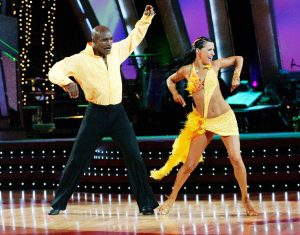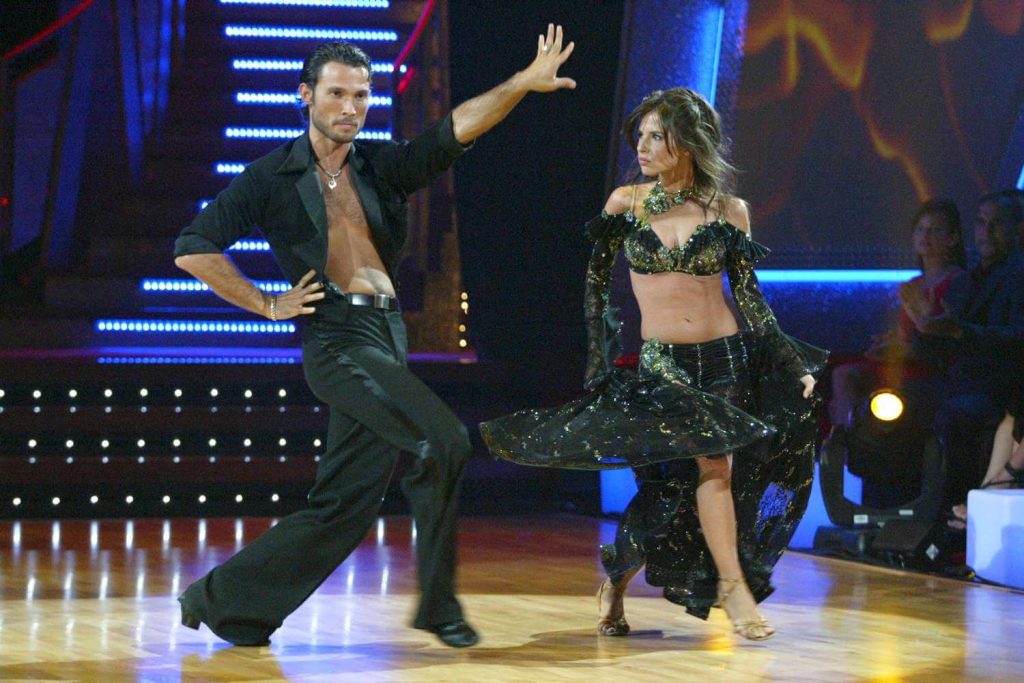Uncategorized
The Birth of Dancing with the Stars: A Deep Dive into Season 1’s Legacy
In 2005, a revolutionary concept arrived on primetime television, blending the glitz of ballroom dancing with the excitement of celebrity culture. Dancing with the Stars quickly became one of the most successful reality shows, drawing millions of viewers each week. But where did it all begin? Season 1 of Dancing with the Stars was a humble, yet powerful, launch that set the stage for what would become a long-running television sensation. From the casting to the choreography, and the unexpected connections made between celebrities and their audiences, Season 1 laid the foundation for what the show is today.
In this article, we will explore the origins of Dancing with the Stars, the key moments and decisions that shaped its first season, and the lasting impact that Season 1 had on the television landscape. We’ll also dive into how the show evolved, how it captured the hearts of viewers, and how it inspired future iterations in the dance competition genre.
The Genesis of Dancing with the Stars: A Reality TV Innovation
Dancing with the Stars was created as a part of a broader trend in reality television, which was rapidly growing in popularity during the early 2000s. Reality TV shows like Survivor, Big Brother, and American Idol had already captured massive audiences by showcasing real people in high-pressure situations. The idea behind Dancing with the Stars was to merge two successful concepts: the celebrity reality show and the beauty and excitement of competitive ballroom dancing.
The show’s format was inspired by the BBC’s Strictly Come Dancing, which premiered in the UK in 2004. In adapting the show for an American audience, Dancing with the Stars incorporated a similar celebrity-and-dance partnership concept, where famous personalities were paired with professional dancers to compete in a series of ballroom routines. The show promised both glamorous performances and a sense of relatability, as viewers could watch celebrities struggle and triumph, often in unexpected ways.
Season 1 debuted on June 1, 2005, and introduced the format to the world. Hosted by Tom Bergeron and Lisa Canning, the first season featured a diverse group of celebrities, each paired with a professional dancer. The inaugural season included a mix of celebrities from various industries—athletes, actors, and even talk-show hosts. The show was structured around weekly dance competitions, where pairs would perform live in front of a panel of judges and the viewing public. Audience votes, combined with the judges’ scores, determined who would stay and who would be eliminated each week.
While the idea of combining celebrities with dance wasn’t entirely new, Dancing with the Stars was unique in its ability to create suspense, drama, and excitement, thanks to the star-studded lineup and the competitive nature of the dance routines. The show’s diverse cast and inclusion of well-known celebrities made it immediately accessible to audiences, ensuring its early success.

The Cast of Celebrities: How They Were Chosen and Their Impact
One of the most important elements that contributed to the success of Dancing with the Stars in its first season was its casting. The show drew from a wide variety of celebrities, choosing personalities who could appeal to different demographic groups. The stars selected were not just popular figures in the entertainment industry—they were also recognizable to audiences, ensuring broad appeal.
The first season’s cast included a mix of television personalities, sports figures, actors, and musicians. Some notable names included Kelly Monaco, an actress best known for her role on General Hospital, and John O’Hurley, an actor and former Seinfeld star. Other celebrities included master of ceremonies and game-show host Tom DeLay, actress Rachel Hunter, and NFL star Jerry Rice. The diversity of the cast ensured that the show attracted viewers from various backgrounds and interests, setting the stage for the wide-ranging success the show would go on to enjoy.
Perhaps the most memorable casting decision was that of Kelly Monaco, who was paired with professional dancer Alec Mazo. Monaco was relatively unknown at the time, and her success in the competition was a surprise to many viewers. Her partnership with Mazo grew into one of the most beloved duos in the show’s history. The chemistry between the two, combined with Monaco’s underdog story, played a significant role in attracting viewers to the show, and Monaco ultimately won the first season.
John O’Hurley, another standout from Season 1, was paired with professional dancer Charlotte Jorgensen. O’Hurley’s performances were often seen as a blend of humor and grace, and he became a fan favorite despite not being a trained dancer. His ability to connect with the audience and deliver performances with charisma made him one of the top competitors of the season. This combination of dancers, celebrities, and personalities helped establish the formula for future seasons, where celebrity backgrounds and their journey in the competition became a central part of the show’s appeal.
The first season’s cast highlighted an important aspect of Dancing with the Stars: the show’s ability to transform ordinary celebrities into dance stars. As the competition progressed, viewers were treated to the journey of each contestant, watching them struggle, improve, and ultimately showcase their dance skills. This storyline—of people coming together, working hard, and achieving success—became a key part of the show’s narrative.
The Role of the Judges: Creating Drama and Building Tension
In any competition-based reality show, the judges’ role is crucial in providing both the structure and drama necessary to keep the audience engaged. In Dancing with the Stars, the panel of judges was responsible for offering critiques, awarding scores, and adding a layer of tension to the show. The initial panel included renowned dancer and choreographer Len Goodman, professional dancer and judge Carrie Ann Inaba, and acclaimed ballroom dancer Bruno Tonioli.
The judges’ varied personalities contributed to the overall dynamic of the show. Len Goodman, with his no-nonsense approach, often provided constructive, albeit blunt, critiques. Carrie Ann Inaba was the emotional one, offering kind words to the contestants while also delivering her opinions on their performances. Bruno Tonioli, known for his over-the-top enthusiasm and flair, brought energy and unpredictability to the panel.
The judges’ reactions to the performances were often part of the drama. Their comments could either lift the contestants to new heights or leave them feeling deflated. Their scorecard, combined with audience votes, determined the fate of the celebrities. While some fans criticized the judges for their harsh comments or overly generous scores, it was clear that they were an integral part of the show’s success.
The tension between the judges also helped make the show more exciting. For example, the back-and-forth between Bruno and Len added an element of unpredictability to each show. These interactions kept the audience engaged and allowed them to feel like they were part of the competition. The judges’ commentary became an expected part of the Dancing with the Stars experience, drawing viewers in week after week.
The dynamic between the contestants and the judges was also important. As the season progressed, the celebrities grew more accustomed to the critiques, and their performances became increasingly polished. For many viewers, the process of watching these celebrities transform from amateurs to skilled dancers was one of the most rewarding aspects of the show.

The Cultural Impact of Season 1: The Birth of a TV Phenomenon
Season 1 of Dancing with the Stars didn’t just become a hit—it became a cultural phenomenon. The show’s ability to mix the allure of celebrity with the spectacle of dance struck a chord with audiences, making it a prime example of how television can tap into multiple facets of entertainment and attract diverse viewers. The success of the first season changed the reality TV landscape, proving that the combination of competition and performance could generate sustained interest.
The format of Dancing with the Stars created a sense of connection with the audience. Unlike traditional talent shows, the contestants were already celebrities, and viewers had a personal stake in their journeys. The idea of watching famous figures—people with whom the public was already familiar—take on something as difficult as ballroom dancing humanized them in a way that had never been done before. Celebrities were no longer untouchable figures but people trying something new and challenging in front of a live audience.
Another significant cultural impact was the rise of ballroom dancing as a mainstream art form. Before Dancing with the Stars, ballroom dance was somewhat niche, primarily associated with professional competitions and certain elite circles. But the show’s immense popularity helped bring ballroom dancing to the forefront, making it more accessible and desirable to the public. From the Waltz to the Tango, viewers were exposed to a wide range of dance styles, many of which were previously unknown to them.
The cultural relevance of Dancing with the Stars also extended to the way it influenced other television programming. The success of Season 1 led to a wave of similar competition shows, many of which incorporated elements of performance or celebrity. In essence, Dancing with the Stars helped shape the direction of reality television in the years that followed, creating a blueprint for how competition and celebrity can be integrated in exciting and engaging ways.
The Lasting Legacy of Season 1: A Blueprint for Future Success
Dancing with the Stars would go on to have multiple seasons, international adaptations, and numerous spin-offs. However, Season 1 remains a pivotal moment in the show’s history, as it set the stage for everything that came afterward. The groundwork laid in that first season—including the casting, the celebrity appeal, and the competition format—has been replicated and refined in each subsequent season.
The enduring popularity of the show, which continues to captivate audiences nearly two decades later, speaks to the universal appeal of dance and the drama of competition. As the seasons progressed, Dancing with the Stars became a platform for both established celebrities and newcomers, offering a unique opportunity for stars to reinvent themselves and connect with their audiences in a completely new way. The continued success of the show serves as a testament to the power of the first season’s formula.
Moreover, the relationships forged between the dancers and their partners, the moments of personal triumph, and the evolution of each season’s cast have become signature elements that fans continue to love. Season 1 may have been the start of the journey, but its impact can still be felt in every performance and every new season.
Conclusion
Season 1 of Dancing with the Stars laid the foundation for what would become a pop culture phenomenon. Through a mix of celebrity allure, competitive dance, and heartwarming personal stories, the show captured the hearts of millions. The lessons learned in the first season continue to shape the show today, and its influence on reality television is undeniable. As Dancing with the Stars moves forward, it will always look back to the groundbreaking success of its first season as the key to its enduring legacy.
From greylittlearrows


